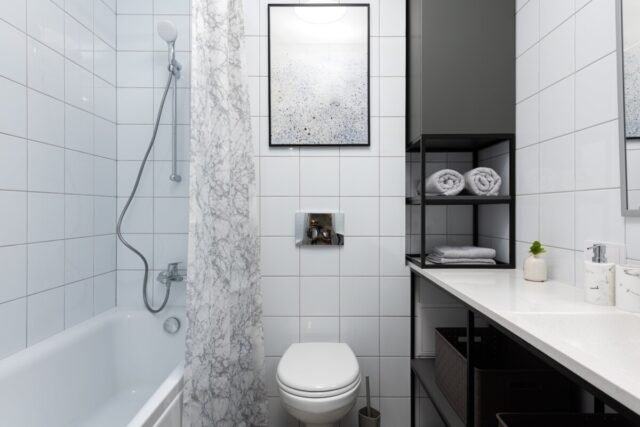Replacing a faulty toilet flapper is one of the easiest and most effective DIY repairs you can do to fix a running toilet. With just a few tools and a little know-how, you can replace the flapper in about 15 minutes.
In this comprehensive guide, you’ll learn everything you need to know about toilet flappers, from understanding how they work to identifying signs of a malfunctioning flapper. You’ll also find step-by-step instructions for replacing a toilet flapper, as well as tips for troubleshooting issues and preventing future problems.
Understanding the Toilet Flapper and Its Importance
The toilet flapper, also known as a flush valve seal, is a rubber component located at the bottom of the toilet tank. It covers the flush valve drain and plays a crucial role in allowing your toilet to function properly.
What is a Toilet Flapper?
The toilet flapper acts as a seal for the flush valve drain. When you flush the toilet, the flapper lifts up, allowing the water in the tank to empty into the toilet bowl. Once the tank is emptied, the flapper then seals off the drain again so the tank can refill.
A properly functioning flapper maintains a tight seal over the flush valve drain. This prevents water from continuously flowing from the tank into the bowl, which is what causes a running toilet.
How Does a Toilet Flapper Work?
The flapper is connected to the flush handle lever via a chain. When you depress the handle, it lifts the flapper up by the chain, breaking the water-tight seal. The water pressure in the tank forces the water to rush out into the toilet bowl.
Once the tank empties, the chain goes slack. The weight and elasticity of the rubber flapper then cause it to fall back down over the drain, sealing the tank so it can refill through the fill valve. This cycle repeats every time you flush.
Why Does a Toilet Flapper Need to Be Replaced?
There are a few reasons why a toilet flapper eventually needs to be replaced:
- Wear and tear – The flapper is made of rubber and sits in water. After years of use, the material wears out and decomposes. Flappers typically last 4-7 years before needing replacement.
- Mineral buildup – Mineral deposits from hard water can form on the flapper over time. This prevents the flapper from forming a tight seal, causing leaks.
- Warping or cracking – Plastic or metal parts connected to the flapper can warp or crack. This can prevent the flapper from sealing properly.
Replacing the flapper is an essential part of routine toilet maintenance. A faulty, leaking flapper can waste hundreds of gallons of water per day and lead to higher water bills.
Signs of a Faulty Toilet Flapper
A failing or faulty toilet flapper will usually show these signs:
- Running toilet – If you can hear water continuously flowing into the toilet bowl, the flapper is not sealing properly. This is the most common symptom of a bad flapper.
- Difficulty flushing – A warped or cracked flapper may get stuck open. This prevents the tank from filling completely, leading to a weak flush.
- Tank not filling – If the tank water level is very low or empty, the flapper may not be closing at all after flushing.
- Toilet cycling on its own – Some flappers may intermittently leak for a few seconds, causing the toilet to run briefly. This is called phantom flushing.
- Higher water bills – A continuously running toilet can waste 200 gallons of water or more per day. This leads to a spike in water consumption and your bill.
Identifying the Root Cause of a Running Toilet
It’s important to distinguish whether the flapper or fill valve is causing the running toilet. Here are some ways to identify the culprit:
- Listen for hissing or flowing water and check if it stops between flushes. If so, the flapper is likely leaking.
- Look at the overflow tube when the tank is full. If water is flowing down, the fill valve is on continuously.
- Remove the tank lid and observe the flapper seal during flushing. A faulty flapper will not close properly.
- Check if the water level drops when no flushing occurs. If so, the flapper isn’t sealing and is allowing water to leak into the bowl.
Distinguishing Between a Flapper and Fill Valve Issue
While both a flapper and fill valve can cause similar symptoms, there are a few key differences:
- Flapper – Leaks intermittently, causes phantom flushing, and water level drops between flushes.
- Fill valve – Water runs continuously, no phantom flushing, and water level remains the same.
- Flapper – Running stops between flushes. Fill valve running is constant.
- Flapper – No water down overflow tube. Fill valve causes overflow.
- Flapper – Weak or incomplete flushes. Fill valve usually maintains normal flush power.
Knowing these differences will help you pinpoint whether you need a new flapper or fill valve. In most cases, a running toilet is caused by a faulty flapper.
Gather the Necessary Tools and Materials
Replacing a toilet flapper is a quick and straightforward project. You don’t need to be an expert plumber. With a few basic tools and a new flapper, you can complete this repair in about 15 minutes.
Essential Tools for Toilet Flapper Replacement
You’ll need the following tools:
- Adjustable pliers – For disconnecting hoses and gripping fittings
- Bucket – For setting aside bolts and gaskets during disassembly
- Clean rags – For wiping up any water drips or spills
- Flashlight – For better visibility in the dark toilet tank
Optional tools:
- Sponge – For soaking up water in the tank or bowl
- Gloves – For protection when handling toilet parts
- Knee pads – For comfort when kneeling on bathroom floor
Selecting the Right Flapper for Your Toilet Model
Replacement flappers are inexpensive, usually $2-$8. However, you need the correct style for your toilet. The most common are:
- Standard flapper – For 2” flush valve, with sliding clip ends. Fits most toilets.
- Korky brand – For 2” and 3” flush valves. Has adjustable cone shape.
- Tower flapper – For 3” flush valve only. Has large cylindrical shape.
Check your existing flapper and measure the flush valve opening to get the right replacement. Consult a home improvement store if unsure.
Finding Compatible Replacement Parts
Besides the flapper itself, you may also need:
- Flapper chain – Links the flapper to the flush handle lever. Replace if rusty.
- Overflow tube – The vertical tube that the flapper seals against. Replace if cracked.
- Flush valve gasket – Creates a seal between tank and bowl. Replace if leaking.
- Fill valve float – May need adjusting to prevent overfilling tank.
Buy multiple replacement parts in advance to avoid multiple trips back to the store.
Step-by-Step Guide to Replacing a Toilet Flapper
Follow these steps to successfully replace a toilet flapper:
Turn Off the Water Supply
- Locate the water supply valve behind or near the toilet. It controls water flow to the toilet.
- Turn it clockwise until tight. This shuts off the water so you can work safely.
Empty the Toilet Tank
- Flush the toilet to drain most of the water from the tank down into the bowl.
- Hold the flapper chain to prevent the flapper from sealing while the tank continues draining.
Detach the Old Flapper
- Disconnect the flapper chain from the flush handle lever.
- Remove the old flapper from the flush valve or overflow tube.
- Use pliers if it’s stuck. Discard the old flapper.
Prepare the New Flapper
- Inspect the new flapper. Ensure the style matches your toilet.
- Attach the flapper chain to the flush handle lever. Adjust to a slack length.
- If needed, trim the flapper chain using pliers. Remove any excess length.
Install the New Flapper
- Align the new flapper properly over the flush valve opening.
- For standard flappers, secure the clips to the overflow tube.
- For other styles, attach as per the manufacturer’s instructions.
- Ensure the flapper is centered and sits flat.
Turn the Water Supply Back On
- Turn the shut-off valve counter-clockwise to restore water flow to the toilet tank.
- Check for any leaks at the connections. Tighten if needed.
Test the New Flapper
- Allow the tank to fill completely, then flush the toilet.
- Verify that the new flapper rises and drops back down properly.
- If needed, adjust the flapper chain length until flush action is smooth.
- Check that water level is correct, not too high or low.
Additional Tips and Considerations
Here are some other useful tips for a smooth toilet flapper replacement process:
Troubleshooting Common Issues
Problem: Flapper doesn’t align properly or falls off when flushing.
Solution: Adjust flapper chain length or trim overflow tube.
Problem: Flapper leaks immediately after install.
Solution: Clean mineral deposits off flush valve. Check gasket seal.
Problem: Toilet flushes weakly or tank level too low.
Solution: Adjust float higher to increase water volume in tank.
Extending the Lifespan of Your Flapper
- Clean the flapper with vinegar and water to prevent mineral buildup.
- Ensure water level in tank is adjusted properly, not too high.
- Use dye tablets in the tank to prevent bacteria growth on the flapper.
- Consider installing a chlorine-resistant flapper for longer life.
Preventing Future Toilet Flapper Problems
- Avoid harsh chemical cleaners that can degrade the flapper material.
- Use a toilet tank cleaning brush regularly to remove debris and buildup.
- Replace plastic or metal components attached to flapper if cracked or warped.
- Check flapper seal and chain connection periodically for signs of wear.
Conclusion
Replacing a faulty toilet flapper is an easy, inexpensive fix that can save hundreds of gallons of wasted water each day. With some basic DIY skills and the right materials, you can replace a leaking, worn-out flapper in about 15 minutes.
Follow the steps outlined here, including turning off the water, detaching the old flapper, installing the new one, and testing the flush action. Be sure to get the correct replacement flapper for your specific toilet model. Adjust the chain length for smooth operation.
Taking the time to proactively replace your toilet flapper can prevent much larger problems down the road. Performing routine maintenance and checks will also help maximize the lifespan of each flapper. With this helpful guide, you can fix a running toilet and prevent excessive water usage.































